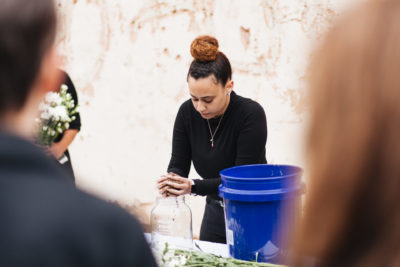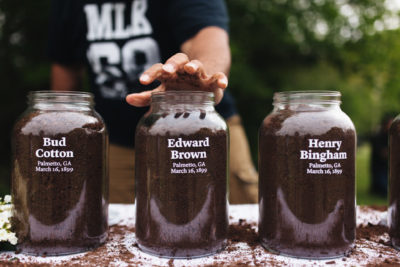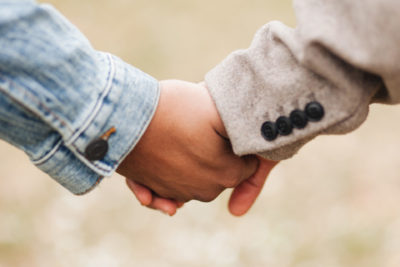Interview with Kayla Duncan of the Fulton County Remembrance Coalition
18 October 2019 – Kayla Duncan and Adina Langer
Editors’ Note: When the Equal Justice Initiative (EJI) opened the Legacy Museum and the National Memorial for Peace and Justice in Montgomery, Alabama, in April 2018, grassroots Community Remembrance was built into the project’s DNA. This Q&A between History@Work lead editor Adina Langer and Kayla Duncan discusses the work of the Fulton County Remembrance Coalition, an organization in Fulton County, Georgia, dedicated to earning an EJI-designated monument for Fulton County.
The Coalition is committed to engaging the local community in intimate conversations about race and racial terrorism and to honoring the memory of the 35 documented lynching victims from Fulton County through collecting soil at sites near where the lynchings occurred. Some soil collected from lynching sites is on display at the Legacy Museum. Other collected soil remains in the counties where the lynchings occurred. To learn more about the National Memorial for Peace and Justice, we invite you to read the review in The Public Historian by Noelle Trent.
Adina J. Langer: Can you tell me a little bit about how the Fulton County Remembrance Coalition (FCRC) came together, and what your involvement in it has been?
Kayla Duncan: The Fulton County Remembrance Coalition (FCRC) began as a community project for five Masters in Social Work (MSW) students, including myself, at Georgia State University. We met our EJI Team Leads, and they gave us a mailing list of individuals who wanted to get more involved after visiting the Legacy Museum: From Slavery to Mass Incarceration and the National Memorial for Peace and Justice. We began having biweekly meetings in October 2018, and our coalition began to grow through networking and word of mouth.

Kayla Duncan. Photo credit: Kayla Duncan
AJL: How has the FCRC been working with the Equal Justice Initiative to claim Fulton County’s designated monument created as a part of the National Memorial for Peace and Justice? Is there a standard process, or is the process customized county by county?
KD: EJI has community guidelines to be followed prior to engaging in the Monument Initiative. EJI prefers communities to first engage in soil collections and historical marker projects to prepare and educate people about the history of racial terror lynching in their communities. FCRC completed the 35 soil collections in May 2019 to commemorate the victims of racial terror lynching in Fulton County, Georgia. We are currently in the process of working with local communities to place historical markers near the sites of lynchings in Fulton County. Although community conversations and historical markers are requisites for claiming a monument from the National Memorial for Peace and Justice, EJI has not yet released the full guidelines for claiming the monument.
AJL: EJI uses the term “racial terror lynchings” to describe the extrajudicial killings of African Americans that occurred between 1877 and 1950, the period of time between the end of Reconstruction and the beginning of the Civil Rights Movement. According to your website, one of your objectives is “Fostering empathy and a drive towards action among those not directly impacted by racism/racial terrorism.” Can you talk more about the term “racial terrorism”? Is the term historical, or more recent in its origins? Do you find that folks who are unfamiliar with the phrase “racial terrorism” ever balk at its use? If so, can you provide tips on how to introduce the phrase and its significance to people who may not have heard it before?

Soil collected for three of the five victims of the Palmetto Massacre. The victims were lynched inside the Johnson Warehouse, a one-story building across the tracks from the old railroad depot in Palmetto. Photo credit: Kayla Duncan
KD: Racial terrorism describes the narrative of injustice against African Americans in this country since slavery. Between 1877 and 1950, abuse and threats of being lynched were racial terrorist tactics used against black people accused of committing a crime. They were often perpetrated by white mobs who denied victims the right to due process, even if there was no evidence against them. Racial terrorism impacts today’s geographic, political, social, and economic conditions of African Americans while reinforcing racial inequality.
While planning soil collections, it was important for us to watch the language describing lynchings and racial terrorism when we visited communities of the victims. Older community members who remembered the stories of victims would be offended if we described the narrative different from the story they were told. When engaging in conversations about racial terrorism, it is important to try and shift the narrative of accusations and blame to one that seeks empathy and understanding.
AJL: Where did the idea for collecting soil from the sites of racial terror lynchings come from? How does your work on soil collection in Fulton County relate to soil collection initiatives elsewhere in the United States? Do you know of examples of this practice at atrocity sites abroad as well?
KD: Bryan Stevenson often refers to the efforts other countries have taken to acknowledge and teach their history. A trip to South Africa will show you the legacy of apartheid; a visit to Germany will show you markers and stones next to the homes of Jewish families. However, in America the legacy of racial terrorism is hidden. Soil collections allow communities to join together and memorialize a person’s life wrongfully taken. After collecting the soil, it is put in a jar with the victim’s name, location, and year of the crime, then placed at EJI. It is part of the larger initiative to reflect on the history of terror lynchings and its impact, while giving power to the victim’s story. FCRC did 35 soil collections to commemorate the lives of the victims and to acknowledge our history, with the hopes of envisioning a future with reconciliation. We now have an exhibit at the Auburn Avenue Research Library called “Stories From The Soil” for people to visit that empowers the victims’ stories and highlights the injustice that took place in this country.
AJL: Many museums and historic sites that have been working on integrating African American history at their sites have collaborated with descendant communities. Have you been able to connect with descendants of the individuals you are commemorating with this project? If so, what have those interactions been like?
KD: For our final soil collection, we were able to connect with the relatives of Thomas Finch. Soil was collected from the home of the Finch family and the soil collection was held behind Grady Hospital, where he died in 1936. It’s an indescribable feeling being at the soil collections with family members. It felt good to stand in solidarity with the family members knowing their loved one’s life was valued, even if it took decades to get to this point. Family members of Mr. Finch said it felt as though they were attending his funeral. Allowing the family to commemorate their family member and be part of the storytelling is a goal we are trying to accomplish. We are hoping to find family members of more victims from Fulton County.
AJL: The idea of the FCRC being a “coalition” implies a coming together of people with diverse backgrounds and reasons for involvement. Have you found this to be the case? What are some of the reasons that members of the coalition have decided to become involved? Have you attracted new people to join the project since it began? What kinds of events have been most impactful for broadening community support?
KD: FCRC is comprised of a diverse group of members who come from different age, race, and religious backgrounds; some are Atlanta natives but others relocated to the city. Most people joined because of the impact they experienced at the Legacy Museum: From Slavery to Mass Incarceration and the National Memorial for Peace and Justice. Other newcomers learned about our coalition from other members. As we continue to pursue the mission of the coalition, some people have joined to help with the reconciliation process by getting this knowledge into school systems and engaging youth, to name a few goals. With every event, the turnout numbers grow larger. “The Impact of a Narrative” panel allowed community members to engage in a conversation about history, trauma, activism, and restorative justice. It aligns with our objective to foster a lasting dialogue in Fulton County and beyond. All of our soil collections allowed community members to learn what happened in their specific city during the planning and engagement process. As we begin the historical marker process, I believe it will engage more community members because a permanent marker will acknowledge history in the place where it occurred.

Two supporters holding hands at a soil collection event as attendees sang “Lift Every Voice and Sing,” a tradition that has developed at the end of every soil collection. Photo credit: Kayla Duncan
AJL: Do you have a vision for the location of Fulton County’s monument from the National Memorial for Peace and Justice once you are able to claim it? What do you see as the relationship between this monument and the Confederate monuments that have been sites of controversy around the region?
KD: Fulton County is such a large county with an unfortunate high lynching number. Most of the lives taken were during the Atlanta Race Riots. I envision it in the city of Atlanta because it represents a story in Atlanta’s history that is not discussed enough. I also think somewhere in the city will allow for more people to see the monument and bring more awareness. However, I’m interested to see what we decide as a coalition. I love the voting process the coalition does during meetings and how we work through the selection process of events, historical markers, and eventually where we will decide to place the Monument as a collective. We’ve spent our time pouring our energy into the details of the soil collections and historical markers because they are vital in the process of our community accepting the Monument long-term.
Confederate monuments represent white supremacy, racial inequality, and those who attempted to protect slavery. EJI’s monument represents a proper acknowledgment of the horror in our history and the continuous advocacy for social justice and equality. The Monument will force uncomfortable conversations that so many have tried to avoid, especially comparing it to Confederate monuments, but it’s necessary for the change needed in America.
AJL: What role should history and historians play in racial reconciliation in the present? What can public historians do to facilitate this work in our daily practices?
KD: Historians tell stories at the core of our collective identity and can assist in shifting the narrative toward racial reconciliation. As a coalition, we recently watched a TED Talk by Baratunde Thurston and the deconstruction of racism in headlines. Public historians can attend community engagement events or organizations trying to progress racial reconciliation and incorporate their learnings into the work they share. Media coverage is playing a role in the divide in this country; however, public historians can counteract the coverage by reporting what is happening in local communities.
~ Kayla Duncan is a recent Master of Social Work graduate from Georgia State University. Duncan’s passion includes ending mass incarceration, addressing racial systemic disparities, and progressing marginalized communities. For the last year, Duncan interned with the U.S. Attorney’s Office as NDGA Community Outreach Specialist to help expand resources for the Project Safe Neighborhood Initiative, in an effort to expand violence and crime prevention in at-risk communities, and reentry-focused community outreach.
~ Adina Jocelyn Langer (she/her/hers) is a lead editor of History@Work and curator of the Museum of History and Holocaust Education at Kennesaw State University. You can follow her on Twitter @artiflection or on the web at www.artiflection.com.




The museums you referenced opened in MONTGOMERY not Birmingham.
Thanks for the correction, Tara! I fixed the error.